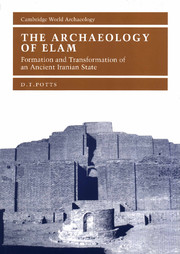Book contents
- Frontmatter
- Contents
- List of illustrations
- List of plates
- List of tables
- Preface and acknowledgements
- List of abbreviations
- Note on transliteration and dating systems
- 1 Elam: what, when, where?
- 2 Environment, climate and resources
- 3 The immediate precursors of Elam
- 4 Elam and Awan
- 5 The dynasty of Shimashki
- 6 The grand regents of Elam and Susa
- 7 The kingdom of Susa and Anshan
- 8 The Neo-Elamite period
- 9 Elam in the Achaemenid empire
- 10 Elymais
- 11 Elam under the Sasanians and beyond
- 12 Conclusion
- References
- Index
9 - Elam in the Achaemenid empire
Published online by Cambridge University Press: 22 September 2009
- Frontmatter
- Contents
- List of illustrations
- List of plates
- List of tables
- Preface and acknowledgements
- List of abbreviations
- Note on transliteration and dating systems
- 1 Elam: what, when, where?
- 2 Environment, climate and resources
- 3 The immediate precursors of Elam
- 4 Elam and Awan
- 5 The dynasty of Shimashki
- 6 The grand regents of Elam and Susa
- 7 The kingdom of Susa and Anshan
- 8 The Neo-Elamite period
- 9 Elam in the Achaemenid empire
- 10 Elymais
- 11 Elam under the Sasanians and beyond
- 12 Conclusion
- References
- Index
Summary
The emergence of the Persians as a major power in western Iran must have been aided by the sustained Assyrian assault on Elam in the seventh century BC. But it is important to stress that, notwithstanding the severity of Assyrian aggression against Elam, the Elamites were neither annihilated nor reduced to a state of utter insignificance. Although it is not uncommon for historians and archaeologists to ignore the role of Elam and the Elamite population in the emergence of the better known Achaemenid Persian empire (539–331 BC), there is much to say on this matter. The very facts that Cyrus the Great established his capital in the heartland of what had been Anshan, that Elamite was the language of the earliest Achaemenid inscriptions and the language of the thousands of administrative texts found at Darius' city of Persepolis, that a number of Elamite rulers tried to rebel against Persian authority, and that Elamite deities continued to be worshipped in the Persian-controlled cities, point to the continuation of an Elamite tradition in southwestern Iran long after Cyrus came to power. Nor was Susa, an important city throughout all earlier periods of Elamite history, neglected by the Achaemenids, and it is from Susa that much of the archaeological evidence of the period comes.
- Type
- Chapter
- Information
- The Archaeology of ElamFormation and Transformation of an Ancient Iranian State, pp. 309 - 353Publisher: Cambridge University PressPrint publication year: 1999

